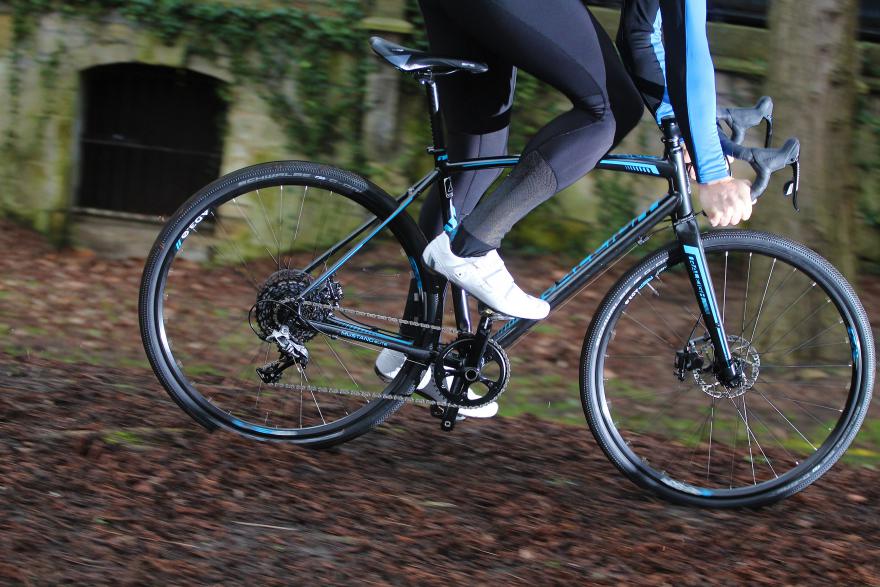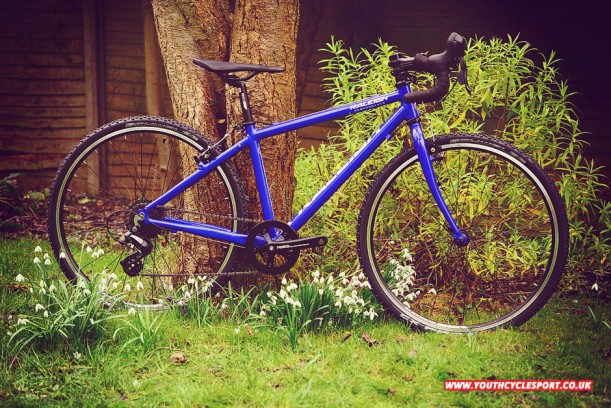The Mustang Elite is one of the more affordable bikes in Raleigh’s new gravel bike range. For £1,000 you get an aluminium frame, and it’s a smart looking thing with a swoopy top tube and big tyre clearance, fitted with TRP hydraulic disc brakes and SRAM’s Rival 1 drivetrain.
It’s really a very good bike this – and don’t let the whole gravel thing put you off, this is simply a good road bike for steady rides and commuting.
If you’re put off the idea of a road bike with skinny tyres (and they can be a bit intimidating to newer cyclists) and want a bit of added comfort and security on the UK’s crumbling road network, the Mustang Elite might be a good choice for you.
The gravel bike category has emerged from the US with plenty of hype, it’s fair to say, but it has resulted in a new breed of road bikes that are well suited to cyclists who value comfort and assured handling over the outright speed and whippy handling of a conventional race bike.
What’s it for?
The Mustang Elite does everything a regular road bike does, but it does it with the added comfort of the big tyres. The tyres, provided you run them at a suitably low pressure (I recommend about 65psi), give the Mustang Elite a very stable ride character. It isn’t easily knocked off line and it doesn’t jiggle you about on a rough road surface.
If you’re not concerned with top speeds and chasing segments on Strava, preferring to spend most of your time at a comfortable cruising speed, the Mustang Elite doesn’t feel laborious. It may not have the outright acceleration of a lighter race bike, and its weight does stunt initial movement at lower speed, but here’s the thing: it’s not a bike designed for sprinting and riding everywhere as fast as you possibly can. It’s intended for allowing you to enjoy cycling as a form of escape and adventure, for taking in the sights and enjoying the freedom and simplicity of getting around with just a jam sandwich powering the engine, rather than glory through suffering and all that nonsense.
For many cyclists, it’s all you really need. It’s right at home on the commute, with the frame accepting mudguards and a rear rack if you need or want them. It’s fine on the weekend club ride and for sneaking in a couple of steady hours on a Sunday morning before lunch. Unless you really need the low weight and speed of a conventional race-inspired road bike, the Raleigh Mustang might actually be a more suitable choice.
But will it go off-road?
Why yes, it will. It won’t rival a cyclo-cross or mountain bike on really tricky and muddy terrain, but for adding a gravelled track such as a canal towpath, a byway or countryside bridleway into your route, the Mustang Elite copes just fine.
There are surprisingly good levels of traction to be gained from the dimpled tread pattern of these new Schwalbe G-One tyres. Just enough grip to stop the wheels slithering about uncontrollably when it gets a bit slick underneath the tyre. Run them at lower pressures and they allow you to explore the sort of countryside terrain that would rapidly intimidate a road bike with skinny tyres.
Best of all, this grip off-road doesn’t come at the expense of performance and speed on the hard stuff. They whizz along just fine. And they really do whizz – they make an unmistakable sound at higher speeds that’ll have you looking over your shoulder until you get used to it. They’re a robust tyre as well, and they’re tubeless-ready if you ever want to ditch the inner tubes at a future date. It’s a smart tyre choice by Raleigh.
Even if you never plan to go near any off-road trails, the Mustang Elite is just fine as a 100 per cent road bike. Many of the roads where I live are rapidly regressing to the Roman roads they once were. Dodging potholes, piles of rocks and loose stones can be a tedious experience on a narrow-tyre race bike. But with the Mustang Elite, you don’t have to be so precious and delicate about line choice.
How does it handle?
The Mustang Elite shares its geometry (the angles and lengths of the various tubes that make up the frameset) with the more expensive carbon fibre Roker. The slack head angle, low bottom bracket and long wheelbase provide the Mustang with fantastic handling; it’s a breeze to ride, anyone will jump aboard and instantly feel at home with the handling.
The 71-degree head angle is slacker than a conventional road bike, and the bottom bracket drop is 75mm, which compares to 69-70mm on a road bike. Those numbers instil the Mustang Elite with the sort of stable and easy handling that is lacking in many road bikes.
Don’t get me wrong, I love tearing around on a fancy race bike, but the Mustang won me over every time I rode it. It does nothing untoward or erratic, no matter how hard you push it. It’s just an easy and comfortable bike to ride.
Steering response is good, with a tolerable level of feedback from the carbon fibre fork with its tapered head tube. There are oversize thru-axles at both wheels which help to resist flex through the frame and fork. You can detect this most noticeably on out of the saddle climbs: there’s no brake rub at all. The thru-axles also make it easier to align the disc rotors when fitting the wheels – handy for travelling.
I detected more road feedback through the aluminium frame compared with the carbon frame of the Roker. Basically, these two models have identical equipment and geometry, it’s just the frame material that is different. The carbon Roker does provide a measurably smoother ride. Perhaps not enough to warrant the extra £1,000 if you’re on a tight budget, though. and the Mustang is certainly not uncomfortable.
Where they do measurably differ is on the scales. The Mustang Elite is 1.5kg heavier than its more expensive sibling, and you do notice this on the climbs. But really, you’ll only notice this if you ride the Roker Pro and then jump immediately onto the Mustang Elite and ride up a 20% climb. And you’re highly unlikely to be doing that. Most of the time the weight isn’t a factor, and the wide-range SRAM gearing ensures you’ve got enough gears to winch up any climb.
Does the SRAM Rival 1 drivetrain work?
Yes, very well. SRAM’s single-ring drivetrain was born in the mountain bike world and it’s made a smooth transition onto gravel and cyclo-cross bikes, where the slightly reduced gearing is less of a bother than it is on top-flight race bikes. Some of the jumps on the huge 10-42t cassette can be a bit troublesome, but most of the time you find a suitable gear, and sit and spin away. The majority of the time I found I was in the right gear, so SRAM has clearly thought carefully about what ratios to offer.
The 44t chainring sounds small compared with a 53t chainring, but with the 10-tooth sprocket there’s more than enough top-end speed for most. Basically, you have to be going like the clappers to really run out of gears, and if you’re doing that on a regular basis, then you can easily swap the chainring for a bigger one. Or find some hills.
How well does it stop?
It stops very well, thanks to the TRP Hy/Rd hydraulic brakes. They’re a fully self-contained design, so they’re compatible with regular cable-pull brake levers. The power and feel is not quite as good as a proper hydraulic setup like you get with Shimano or SRAM’s hydro disc groupsets, but it’s a step above other mechanical disc brakes.
Disc brakes have found a natural home on bikes like this, because of the control of the extra braking performance, and also because they allow the frame and fork to accommodate wider tyres. There’s also plenty of clearance between the frame and tyres for mudguards or mud.
I like tubeless. Can I convert the wheels?
Raleigh has fitted the bike with its own-brand RSP AD3.0 wheels which feature an aluminium rim that is tubeless-ready. Also tubeless-ready are the Schwalbe tyres, so to convert to tubeless it’s just a matter of removing the inner tubes, fitting the supplied tubeless valve, adding some sealant, and tubeless you go.
Anything else?
The Raleigh RSP branded aluminium handlebar, stem and seatpost aren’t anything fancy but they do the job just fine. The handlebar has a nice shape with a compact drop which makes it usable when riding off-road when you need a bit more control. More of a flared drop would increase off-road control even more.
The bike has all the necessary eyelets to accommodate mudguards and it’ll take a rear rack, plus there are two sets of bottle cage mounts.
What of its rivals?
This is a competitive price point and the gravel bike category is getting more popular all the time. The Mustang Elite has to fend off competition from the excellent GT Grade Alloy 105(link is external), which costs the same and also features an aluminium frame and wide tyres, and even the same TRP hydraulic disc brakes. Both offer a very similar riding experience and both provide mudguard and rack fittings if those are important to you. For me, the Mustang Elite pips the GT Grade because of the tubeless-ready wheels and tyres, and the simpler SRAM Rival 1 drivetrain.
The Mustang, with the same frame, is also available at £650 with a Shimano Claris groupset, and the Mustang Sport, at £800, has Shimano Sora parts. Those two models feature regular double chainsets and mechanical disc brakes. The Mustang range tops out with the £1,500 Comp, which upgrades to a SRAM Rival 1 hydraulic groupset and American Classic wheels.
Verdict
The Mustang Elite is affordable, adaptable and accessible – a good buy for the money
















 itself has alternating wide and narrow teeth, which, it is claimed, mesh better with the wide and narrow links in the chain and so hold the chain more securely than a standard design while promoting mud-clearance.
itself has alternating wide and narrow teeth, which, it is claimed, mesh better with the wide and narrow links in the chain and so hold the chain more securely than a standard design while promoting mud-clearance.








